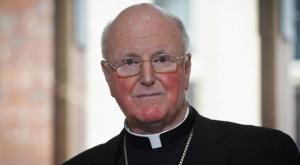 The scientific justification for atheism has begun to crumble. Scientific reasoning, scrupulously applied, leads to questions that can be answered most probably (but not certainly) by positing the existence of a transcendent creator. This much I suggested in last week’s blog.
The scientific justification for atheism has begun to crumble. Scientific reasoning, scrupulously applied, leads to questions that can be answered most probably (but not certainly) by positing the existence of a transcendent creator. This much I suggested in last week’s blog.
But if atheism is not the logical result of scientific thinking, then what is it? I would suggest that atheism has become: “(1) a system of symbols which acts to (2) establish powerful, pervasive, and long – lasting moods and motivations in men (3) formulating conceptions of a general order of existence and (4) clothing these conceptions with such an aura of factuality that (5) the moods and motivations seem uniquely realistic.” Which is the now classic definition of religion formulated by the anthropologist Clifford Geertz.
First I should note that not all atheists are religious in this sense. For them belief in God became irrelevant at some point, and they have continued living without God quite happily. God’s existence or non existence is simply not relevant to their understanding of reality.
Atheism as a religion, on the other hand is the determined effort to construct an understanding of reality that neither has, nor needs a transcendent element. Typically this is associated in the West with science, or properly scientism. Indeed the term scientism is probably both fairer and more appropriate. Why should a religion have to name itself in terms of its opposition? Yet atheist and atheism are the terms used by atheists themselves while scientism doesn’t yet have any great currency, so I’ll stick with the preferred label of people like Richard Dawkins, Sam Harris, and Neil deGrasse Tyson.
By “system of symbols” Geertz doesn’t just mean iconic representations of ideas. He means all sorts of repeated speech acts, formulaic actions, uniform clothing, and so on. These function for believers to create and reinforce a coherent and self-referential thought world. Attending a science conference will plunge one into such a system of symbols. Watching DeGrasse Tyson’s “Cosmos” is similar since it takes atheism into the popular consciousness and becomes a weekly ritual for those who deny the existence of God.
And the symbols are as fascinating as they are consciously constructed. DeGrasse Tyson systematically used darkened, shadowy, and sinister figures to represent religious believers and leaders. And he places his cartoons in a systematic presentation of history as extending from innocent but ignorant efforts to explain the natural world to the rise of powerful religious resistance to enlightened science. Dawkins, Harris, and others – really going back to the French atheists of the Enlightenment – have effectively tried to make this the standard history of the human quest for knowledge. And in doing so they have created a pervasive symbolic representation of their understanding of reality.
In doing this they are quite intentionally establishing “powerful, pervasive, and long – lasting moods and motivations.” And they are co-religionists in this with groups like The Freedom from Religion Foundation, which uses its advertisements in Scientific American and elsewhere to alternatively mock religious belief and assert the comprehensiveness and reliability of science. The mocking in particular acts to both reassure and motivate atheists in their skepticism and rejection of religion, even as it encourages them embrace of one another’s company and mutual affirmation. Like almost all religions, atheism places a heavy emphasis on cultivating a mood of moral and intellectual superiority. There is even a dating site for scientists who want to meet and mate with their own kind. (https://www.datingforscientists.com.)
The moods then “formulate conceptions of a general order of existence.” For atheists it is a general order of existence that is entirely comprised by that which is accessible to human manipulation and reason, at least in theory. The natural world is the only world, and everything else fantasy not worthy of consideration. Or as the Freedom from Religion Foundation put it in a recent ad (Scientific American Sept. 2017) “I don’t believe in God because I don’t believe in Mother Goose.”
Finally atheism clothes “these conceptions with such an aura of factuality that the moods and motivations seem uniquely realistic.” Perhaps the key characteristic of the apostles of Atheism is their selective use of science to create a naturalistic understanding of reality that seems inevitable, and their mocking of religion fully justified. Watching Cosmos,and reading Dawkins or Christopher Hitchens one never finds mention of the problem of the anthropic principle so carefully examined by not only Spitzer (see previous blog) but by serious cosmologists such as Weinberg and Hawking.
Indeed Wienberg, in his book Dreams of a Final Theory, makes clear that the choice to pursue purely naturalistic explanations and reject metaphysics is just that, a choice; one that he paints as heroic but which is nonetheless a matter of faith.
But rather than admitting the element of fiat Michael Shermer wrote in 2012 “Why turn to the supernatural when our understanding of the natural is still in its incipient stages? We would be wise to heed this skeptical principle: before you say something is out of this world, first make sure that it is not of this world.” In short he turns into a matter of principle what is in fact a choice based on the aura of factuality around naturalism that makes its moods and motivations seem uniquely realistic.
And in this atheism has become a religion. One with which other religions, not least Christianity, needs to be in dialogue. But as we do so we must recognize that this is not a dialogue between religion and science. It is an inter-religious dialogue between two ways of comprehending the world; each committed to rational inquiry, logical coherence, and the pursuit of truth. And hopefully, as Carl Sagan fervently hoped in his work Science a Light in a Demon Haunted World, a dialogue between those equally committed to a future in which humanity and indeed all creation flourishes. Sagan understood that science has its own spirituality, even as atheism makes faith demands – something that Christians would be advised to recognize and honor, and something the followers of atheism would do well to admit and embrace.











